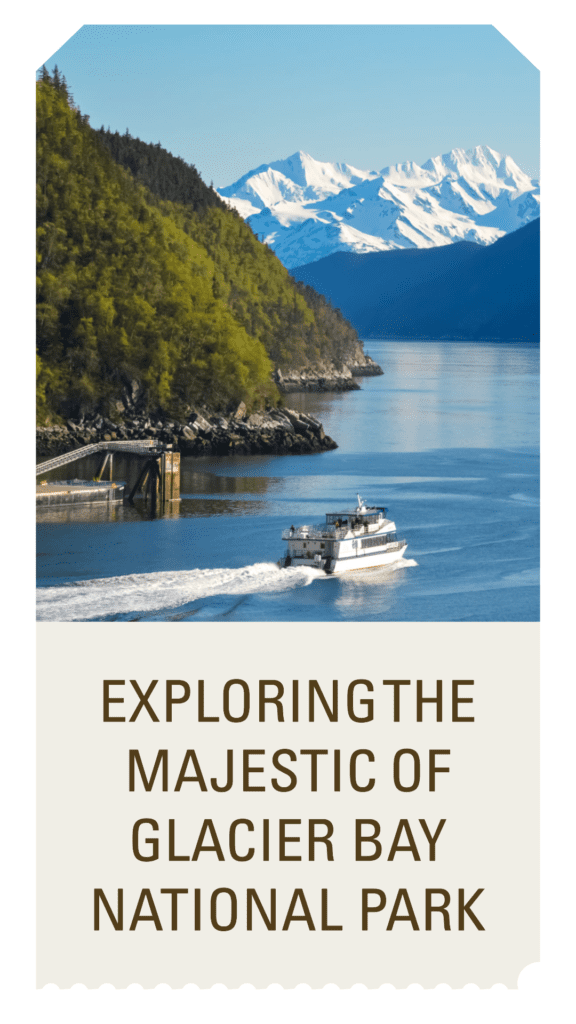Glacier Bay National Park
Nestled in the rugged wilderness of Alaska, Glacier Bay National Park is a mesmerizing wonderland that beckons adventurers and nature enthusiasts alike. With its icy blue glaciers, dramatic fjords, and thriving marine ecosystem, Glacier Bay offers an unparalleled opportunity to witness the power and beauty of nature. Let us embark on a journey to discover the wonders of Glacier Bay National Park and delve into its captivating allure.
At the heart of the park lies a captivating display of glaciers, sculpted over thousands of years by the forces of nature. These immense rivers of ice, such as the Margerie Glacier and the Grand Pacific Glacier, command attention with their towering walls of ice and breathtaking calving displays. Witnessing the thunderous ice crash into the sea is an awe-inspiring spectacle that leaves visitors in awe of nature’s grandeur.
Glacier Bay National Park is home to magnificent fjords, carved by retreating glaciers and filled with tranquil waters. These deep, narrow inlets provide a stunning backdrop for exploration and offer a peaceful wildlife sanctuary. Cruising through the fjords allows visitors to witness towering cliffs, cascading waterfalls, and hidden coves, creating a sense of serenity and wonder.
Glacier Bay National Park offers a variety of hiking trails that lead visitors through its diverse landscapes. From temperate rainforests to alpine meadows, these trails allow for an intimate exploration of the park’s terrestrial ecosystems. Discover hidden waterfalls, lush vegetation, and the possibility of encountering wildlife, all while revelling in the tranquillity of this remote wilderness.
Glacier Bay National Park is also home to the ancestral lands of the Huna Tlingit people. The park recognizes the importance of preserving its cultural heritage and offers opportunities to learn about its traditions, history, and ongoing connections to the land. Engage in interpretive programs and exhibits to gain a deeper understanding of the rich cultural tapestry woven into Glacier Bay.

What is so special about Glacier Bay National Park?
Glacier Bay National Park is a place of extraordinary natural beauty and ecological significance. The park showcases the dynamic nature of glaciers, where massive rivers of ice sculpt the landscape and offer a glimpse into Earth’s geological history. The park’s pristine fjords, with their towering cliffs and tranquil waters, create a sense of awe and tranquillity. Additionally, Glacier Bay’s thriving marine ecosystem, abundant with whales, seals, sea lions, and seabirds, provides a unique opportunity to witness the interconnectedness of marine life in its natural habitat.
Is Glacier Bay National Park worth visiting?
Absolutely! Glacier Bay National Park is a destination that is undoubtedly worth visiting for nature enthusiasts, adventure seekers, and those seeking a deep connection with the natural world. The park’s majestic glaciers, stunning fjords, and diverse wildlife offer an immersive and transformative experience. Whether you embark on a glacier cruise, explore the park’s hiking trails, or revel in the serenity of this untouched wilderness, Glacier Bay promises a memorable and awe-inspiring journey.
Are there polar bears in Glacier Bay?
While Glacier Bay National Park is renowned for its diverse wildlife, including marine mammals and birds, polar bears are not commonly found in the park. Due to the park’s location and climate, polar bears typically inhabit regions further north, such as the Arctic. However, visitors may encounter other iconic wildlife species, such as brown bears, seals, sea lions, and humpback whales, during their exploration of the park.
Are there orcas in Glacier Bay?
Yes, orcas, also known as killer whales, can be spotted in the waters of Glacier Bay National Park. These magnificent marine mammals are known for their striking black and white markings and their social behaviour. Glacier Bay provides a rich feeding ground for orcas, as they prey on fish, seals, and other marine animals. Observing orcas in their natural habitat is a thrilling experience and adds to the allure of Glacier Bay’s diverse marine ecosystem.
Fast Facts About Glacier Bay National Park and Preserve
| Name | Glacier Bay National Park and Preserve |
| Established | 2nd December 1980 |
| Area | 3,223,384 acres (13,044.57 km2) |
| National monument | Since 1925 |
| World heritage site | Since 1992 |
| Nearest City | Juneau |
| Estimated Visitors | 89,768 (in 2021) |
| Official Website | https://www.nps.gov/glba/index.htm |
Getting There
Explore Glacier Bay National Park in southeastern Alaska by embarking on a variety of transportation options. You can choose to travel by cruise ship, or small ship cruise, or opt for scheduled air or boat service from Juneau and other communities in the region. Another thrilling option is to join a multi-day sea kayaking tour. For additional details and inquiries, you can contact the National Park Service at 907-697-2230 or visit the official website of Glacier Bay National Park.
- Throughout the year, numerous air taxi companies offer small-plane flights from various towns in southeast Alaska to Gustavus.
- A limited-schedule passenger ferry facilitates transportation between Juneau and Gustavus/Bartlett Cove.
- Alaska Airlines offers daily flight service from Seattle and Anchorage to Juneau, providing convenient connections through multiple carriers to reach Gustavus.
- You can reach the neighbouring town of Gustavus by either air or passenger ferry.
Glacier Bay National Park stands as a testament to the raw beauty and power of nature. Its glaciers, fjords, and diverse marine life create a captivating landscape that leaves visitors in awe. Whether cruising through icy waters, hiking amidst lush forests, or witnessing the majesty of calving glaciers, Glacier Bay offers a transformative experience that connects individuals with the natural world. Embrace the adventure, serenity, and wonder of Glacier Bay National Park, and let its majestic beauty leave an indelible mark on your soul.


